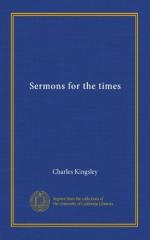Jerusalem was thus in utter need and danger; the vast army of the Assyrians was encamped at Lachish, not more than ten miles off; and however strong the walls of Jerusalem might be, and however advantageously it might stand on its high hill, with lofty rocks and cliffs on three sides of it, yet Hezekiah knew well that no strength of his could stand more than a few days against Sennacherib’s army. For these Assyrians had brought the art of war to a greater perfection than any nation of the old world: they lived for war, and studied, it seems, only how to conquer. And they have left behind them very remarkable proofs of what sort of men they were, of which I think it right to tell you all; for they are most instructive, not merely because they prove the truth of Isaiah’s account, but because they explain it, and help us in many ways to understand his prophecies. They are a number of sculptures and paintings, representing Sennacherib, his army, and his different conquests, which were painted by his command, in his palace; and having been lately discovered there, among the ruins of Nineveh, have been brought to England, and are now in the British Museum, while copies of many of them are in the Crystal Palace. There we see these terrible Assyrian conquerors defeating their enemies, torturing and slaughtering their prisoners, swimming rivers, beating down castles, sweeping on from land to land like a devouring fire, while over their heads fly fierce spirits who protect and prosper their cruelties, and eagles who trail in their claws the entrails of the slain. The very expression of their faces is frightful for its fierceness; the countenances of a ‘bitter and hasty nation,’ as the Prophet calls them, whose feet were swift to shed blood. And as for the art of war, and their power of taking walled towns like Jerusalem, you may see them in these pictures battering down and undermining forts and castles, with instruments so well made and powerful, that all other nations who came after them, for more than two thousand years, seem to have been content to copy from them, and hardly to have improved on the old Assyrian engines.
Such, and so terrible, they came up against Jerusalem: to attempt to fight them would have been useless madness; and Hezekiah had but one means of escaping from them, and that was to cast himself and his people upon the boundless mercy, and faithfulness, and power of God.




